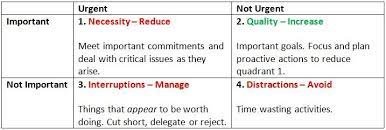Managing time effectively is vital if you are to prosper as a business owner, especially when it comes to running a small business when just a few people have to deal with every aspect of the business.
Despite best intentions though, we’ve all got to the end of a day without achieving any of the tasks we intended to do at the start of the day.
There are many tips, tools and guides online and in print that deal with the age old issue of time management. Most seem to over-complicate something that really shouldn’t be that complicated in principle, but Covey’s Matrix has stood the test time and is something that all business owners can benefit from.
It’s the simplicity of Covey’s Matrix when it comes to visualising how and where your time should be spent, that makes it such a popular tool among management consultants.
In this article, I want to go through the fundamentals, before going onto look at a very real problem that threatens to sap many a small business owner’s time, and how to deal with it.
What is Covey’s Matrix?
Covey’s Matrix is a box divided into four areas, or ‘quadrants’ (see image below), with each representing how your work time is divided up according to importance and urgency.

The matrix as a whole represents the time you have, so the size of this cannot be changed, but each quadrant can be changed, depending on how much time you spend in it. The general idea is to try and shift as much of your time into quadrant two, whilst reducing that spent in the others. To Covey, this is the simple truth behind time management and as a theory, it is very elegant.
But how does it work in practice? Let’s explore each quadrant in turn, to give you some practical examples;
Quadrant 1: Important and Urgent (Do it now)
It is quite necessary to have some flexibility here, as it can cover crisis events that simply cannot be planned for and can be extremely time-sensitive (often technical issues such as servers or systems falling over can necessitate a lot of your time ending up in this quadrant on occasion).
Tasks can fall into this quadrant because of poor time management though and that is usually an indicator you’re not spending enough time in quadrant two.
Quadrant 2: Important and Not Urgent (Do later)
This is the quadrant where you should ideally be spending most of your time. The goal is to work on important tasks before they become urgent and cause an imbalance in your overall time schedule.
The key here is staying on top of your workload and pro-actively dealing with important tasks. This is easier said than done of course and pro-active managers and business owners have often had to fight hard and learn to delegate work effectively to reduce the volume of work falling into the next two quadrants.
Quadrant 3: Not Important and Urgent (Delegate)
In a business setting, work that is urgent but not actually important (to you at least) will often include problems that are brought to you from your staff. This is often referred to as ‘staff imposed’ time and you need to reduce it as much as possible.
It is worth directing your attention here to the concept of monkey management as ‘staff imposed’ time can be one of the biggest issues facing managers and business owners fighting an uphill battle when it comes to their own time management.
To explain, the monkey in the metaphor refers to someone else’s problem that you take on your own shoulders by agreeing to ‘look into it’. Not only does this stop you from getting on with tasks related to your role, but it can hold back staff development and even create a culture of buck passing.
Monkey management means learning to say no to people and enabling them to manage their own problems.
Quadrant 4: Not Important and Not Urgent (Don’t do/Avoid)
You could consider tasks in this quadrant as wasteful – unnecessary meetings or phone calls, for example.
Part of the problem with the so-called ‘distractions’ quadrant is that you don’t realise you are in it until you have the benefit of hindsight. As such it’s important to learn to recognise wasteful activities, even if it’s with the benefit of hindsight, so you can avoid them or delegate them to your staff in future.
Putting it into action
Time management can be a very personal thing but there are principles that apply to pretty much every small business owner or manager out there. It is these principles that the Covey Matrix so brilliantly describes and categorises.
The more time you spend using Covey’s Matrix, the more aware you will become of where your workload sits in each quadrant. The only thing you have left to do after this is to shift your time in the right direction.
Review your diary for last week against these priorities , be painfully honest with yourself. What proportion of time was allocated to each quadrant? Review your planned diary for next week and look at what changes you could make to be more effective.
This article has been written for ByteStart by Peter Quintana, Director of Bristol based management consultancy, High Growth Knowledge Company. He has many years of experience working with established businesses in a number of industry sectors, from engineering and healthcare to digital and creative, helping directors overcome the challenges of managing sustainable growth.
Subscribe to ByteStart's monthly small business owners' newsletter!

|
Free Tide Business Bank Account - up to £150 Cashback!Simply open a free business current account to qualify + 12 months free transactions. Read our Tide review. Open a Tide savings account at the same time and earn an excellent 4.07% AER (variable) on your spare funds. |











